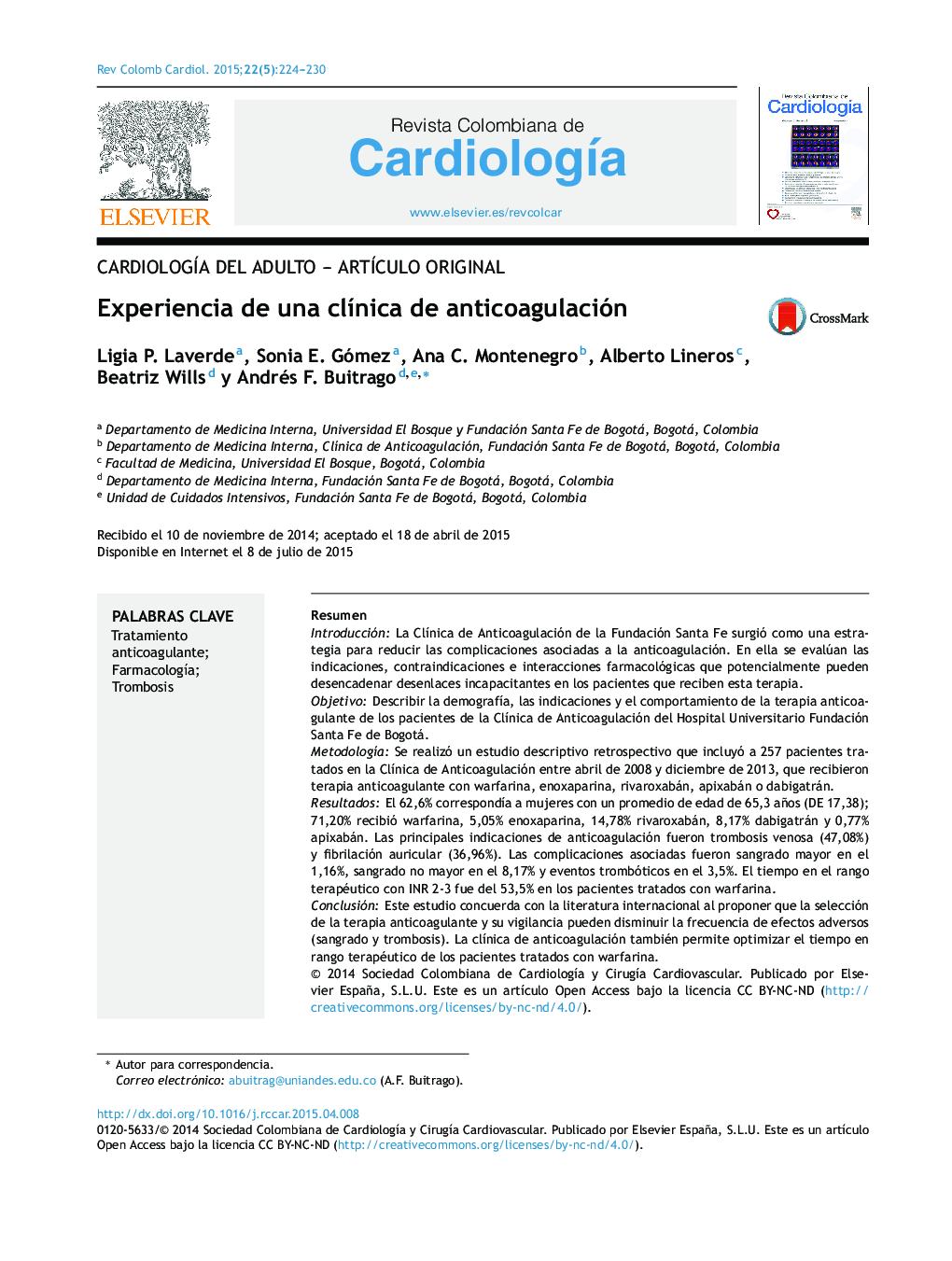| کد مقاله | کد نشریه | سال انتشار | مقاله انگلیسی | نسخه تمام متن |
|---|---|---|---|---|
| 3012053 | 1181785 | 2015 | 7 صفحه PDF | دانلود رایگان |
ResumenIntroducciónLa Clínica de Anticoagulación de la Fundación Santa Fe surgió como una estrategia para reducir las complicaciones asociadas a la anticoagulación. En ella se evalúan las indicaciones, contraindicaciones e interacciones farmacológicas que potencialmente pueden desencadenar desenlaces incapacitantes en los pacientes que reciben esta terapia.ObjetivoDescribir la demografía, las indicaciones y el comportamiento de la terapia anticoagulante de los pacientes de la Clínica de Anticoagulación del Hospital Universitario Fundación Santa Fe de Bogotá.MetodologíaSe realizó un estudio descriptivo retrospectivo que incluyó a 257 pacientes tratados en la Clínica de Anticoagulación entre abril de 2008 y diciembre de 2013, que recibieron terapia anticoagulante con warfarina, enoxaparina, rivaroxabán, apixabán o dabigatrán.ResultadosEl 62,6% correspondía a mujeres con un promedio de edad de 65,3 años (DE 17,38); 71,20% recibió warfarina, 5,05% enoxaparina, 14,78% rivaroxabán, 8,17% dabigatrán y 0,77% apixabán. Las principales indicaciones de anticoagulación fueron trombosis venosa (47,08%) y fibrilación auricular (36,96%). Las complicaciones asociadas fueron sangrado mayor en el 1,16%, sangrado no mayor en el 8,17% y eventos trombóticos en el 3,5%. El tiempo en el rango terapéutico con INR 2-3 fue del 53,5% en los pacientes tratados con warfarina.ConclusiónEste estudio concuerda con la literatura internacional al proponer que la selección de la terapia anticoagulante y su vigilancia pueden disminuir la frecuencia de efectos adversos (sangrado y trombosis). La clínica de anticoagulación también permite optimizar el tiempo en rango terapéutico de los pacientes tratados con warfarina.
IntroductionThe anticoagulation clinic emerged as a strategy to reduce the complications associated with anticoagulation therapy. There, the indications, contraindications and drug interactions that could cause potential functional disabilities of individual patients receiving this treatment are evaluated.ObjectiveTo describe the demographic profile and pharmacologic indications and to determine the behavior of anticoagulant therapy of patients consulting at the Anticoagulation Clinic of the University Hospital Fundación Santa Fe de Bogotá.MethodsA descriptive retrospective study was carried out that included 257 patients of the anticoagulation clinic between April 2008 and December 2013, who received anticoagulation therapy with warfarin, enoxaparin, rivaroxaban, apixaban or dabigatran.Results62.6% were female; the average age was 65.3 years old; 71.20% received warfarin, 5.05% enoxaparin, rivaroxaban 14.78%, 8.17% dabigatran and 0.77% apixaban. The chief indications for anticoagulation were venous thrombosis (47.08%) and atrial fibrillation (36.96%.) Leading complications associated with total anticoagulant strategy were: major bleeding (1.16%), mild bleeding (8.17%) and re-thrombotic events (3.5%). The time spent in therapeutic range (INR 2-3) was 53.5% in the warfarin group.ConclusionThis study is consistent with international literature in suggesting that the selection and monitoring of anticoagulation therapy could reduce the frequency of adverse effects (bleeding and thrombosis). The anticoagulation clinic also allows to optimise the time in the therapeutic range of the patients treated with warfarin.
Journal: Revista Colombiana de Cardiología - Volume 22, Issue 5, September–October 2015, Pages 224–230
